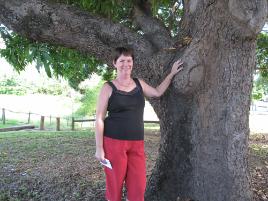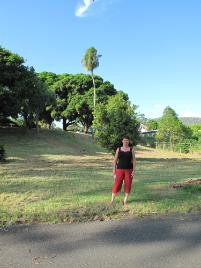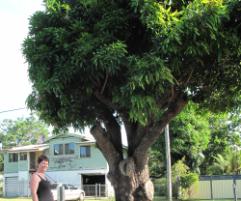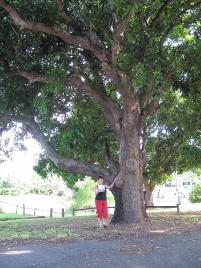Famous Rocky garden reluctant to give up its secrets
Published on 10 March, 2011
When Susan Cunningham bought a rundown house built on a former market garden in Rockhampton's Rockonia Road area in the 1990s, she had no idea how consumed she would become by the story behind the land...
LINK to Beef capital shoots Bowen arrow, claims mango too

Susan inspects one of the huge mango trees beside the Thozet gravesite in Codd Street
It turns out the land was once part of the sweeping experimental garden estate called Muellerville which once boasted avenues of Norfolk Pine and was world-renowned as the Australian base of globe-trotting French botanist Anthelme Thozet.
[The 28-hectare Muellerville estate was on an area now bounded by Thozet Road, Thozet Creek, Rockonia Road and the Fitzroy River].
But the more Susan dug into the legend of Thozet, who was also a publican, the more disputed facts she uncovered.
She also found a number of parallels with her own life which have sustained her interest over a period of more than a decade.
Like Susan, Thozet seems to have come from a relatively poor family background, yet he managed to become educated and became a champion of environmental causes long before they became fashionable. Susan can relate to this trajectory. She also comes from a family with no exposure to tertiary study but completed honours in Biology as an adult-entry student with CQUniversity, once worked for Capricorn Conservation Council and now works as a Vegetation Management Officer.

The hillside leading to the Thozet gravesite
"A key mystery is that there is an inherited affection for Thozet which has been passed down through the generations in Rockhampton, yet no-one can recall exactly where the affection comes from," Susan said.
"One theory, given that he was left-leaning, is that perhaps as the owner of a garden producing many food crops he became the go-to guy for destitute families needing to feed their children."
There's also uncertainty about the whereabouts of a pen-and-ink sketch of Thozet (which would be handy for CQUniversity's Thozet Building records) and a range of medals presented to him, which were once housed in the School of Arts in Rockhampton."
Susan said another mystery was how the Thozet family obelisk came to be stripped of its plaque and used to denote the grave of a local councillor. Meanwhile, there's a legend that a statue found in a local creek was one commissioned by Madame Maria Thozet in memory of her son Auguste, yet there are no hard facts.

Susan believes this could have been the first of the mango trees planted
There's a irregular-looking sign on a park on the former Thozet land which says 'Norris Park', yet there's no council record of the naming, so Susan intends to apply for it to be named Muellerville Park in honour of the Thozet family.
She agrees that there's already a Thozet Road, a Thozet Creek and possibly a Thozet Bridge in the area, as well as a Thozet Building at CQUniversity Rockhampton Campus and a Thozet plaque on the riverbank (Frenchmans Creek and the suburb of Frenchville were also named after Thozet), but she says Muellereville was such as wonderful part of Australian history that it should be recognised as well.
There's some suggestion that a mango tree in Mason Street was the very first one planted in Australia. Thozet is said to have grown the first cotton in Australia and the first wheat in Rockhampton, as well as pioneering the study of Aboriginal bush tucker. The estate helped introduce other commercial crops to the region, including tea, sugar, coffee, pepper, spices and olives.
"He grew sugar cane and timber plantations and had a significant citrus orchard, helping with his ground-breaking research into the orange borer moth. If a member of the public wanted specimens, Thozet would also supply cultivation notes, meaning he was doing extension work, like an early Don Burke."

Susan beside one of the huge mango trees in Codd Street
Thozet had a significant role in establishment of the Rockhampton Botanic Gardens, helped to plan South Rockhampton Cemetary and planted fig trees along the Fitzroy River which still stand to this day.
He and his wife returned to Europe for several years to give presentations on Australian plants and growing conditions and stopped off in London to lobby for separation of the north of the State of Queensland.
Thozet was only 52 when he died in 1878 after 12 days of bilious fever contracted during an expedition to Bluff. He was buried at Muellerville.
Madame Thozet lived much longer and got to witness a significant chunk of the 20th century. But after she died (aged 85 in 1923) Muellerville - by this time only an echo of its former glory - was sold off and eventually chopped up for residential land.
Susan has made contact with academics and others interested in researching Thozet and has established a website at www.thozet.com to help with finding and sharing of original source materials.

